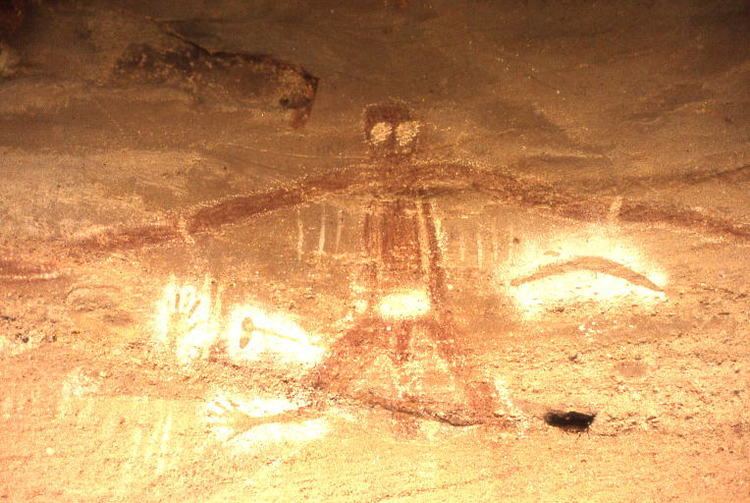 | ||
Aboriginal sacred sites are areas or places in the Australian landscape of significant Aboriginal Australian meaning within the context of the localised indigenous belief system, known as The Dreaming, which has its origins in Dreamtime. Sites sacred to Aboriginal people are part of Australia's cultural heritage, connecting the land with the cultural values, spiritual beliefs and kin-based relationships of the local people.
Contents
Land and The Dreaming
The Aboriginal population of Australia is made up of many tribes and nations, each with their own sacred places, animal totems and other items in the geographic area known as their ‘country’.
Sacred sites are places within the landscape that have a special significance under Aboriginal tradition. Hills, rocks, waterholes, trees, plains and other natural features may be sacred sites. In coastal and sea areas, sacred sites may include features which lie both above and below water. Sometimes sacred sites are obvious, such as ochre deposits, rock art galleries, or spectacular natural features. In other instances sacred sites may be unremarkable to an outside observer. They can range in size from a single stone or plant, to an entire mountain range.
The Dreaming is a term used to refer collectively to Aboriginal religious beliefs. These beliefs endeavour to explain the questions of ultimate human reality, including the origins of humans and animals. The Dreaming is an ongoing phenomenon, incorporating the past, the present and the future. Aboriginal people believe that the Spirits who initially inhabited the land were their ancestors and their identity is derived from the Spirits from whom they descended. Particular tribes have their own totem which is an animal often native to their tribe's territory. Their traditional way of life is based on their relationship with the land, which they believe to be their origin, sustenance and ultimate destiny. They believe it is their duty to look after the land and take only what is needed. The beliefs of the Dreaming are diverse and various. They depend on an individual's tribe, gender, location and totem.
Traditional custodians and management
The traditional custodians of the sacred sites in an area are the tribal elders. "Sacred sites give meaning to the natural landscape. They anchor values and kin-based relationships in the land. Custodians of sacred sites are concerned for the safety of all people, and the protection of sacred sites is integral to ensuring the well-being of the country and the wider community." These sites are or were used for many sacred traditions and customs. Sites used for male activities, such as initiation ceremonies, may be forbidden to women; sites used for female activities, such as giving birth, may be forbidden to men.
Legislation
Before 1965 there was no legislation protecting Aboriginal sites in Australia, with the exception of some regulations in the Northern Territory. In 1965, the South Australian Government was the first to introduce legislation, and all other States have since done so.
Legislation relating to the protection and management of sacred sites in Australia includes:
Criminal offences apply under Commonwealth and state and territory laws for unauthorised access to sacred sites. Damage to these sites can also result in civil penalties.
Some examples
Some documented examples of Aboriginal sacred sites in Australia include:
Sacred sites in the media
In June 2008 BBC released the series Ray Mears Goes Walkabout, composed of four episodes, where Mears tours the Australian outback. An accompanying hardcover book was published in the UK by Hodder and Stoughton in March 2008. In the series, Mears meets one of his heroes, Les Hiddins (a.k.a. "The Bush Tucker Man"), and he also heads to the Kimberley region to meet the reputed aboriginal artist and bush guide Juju Wilson.
